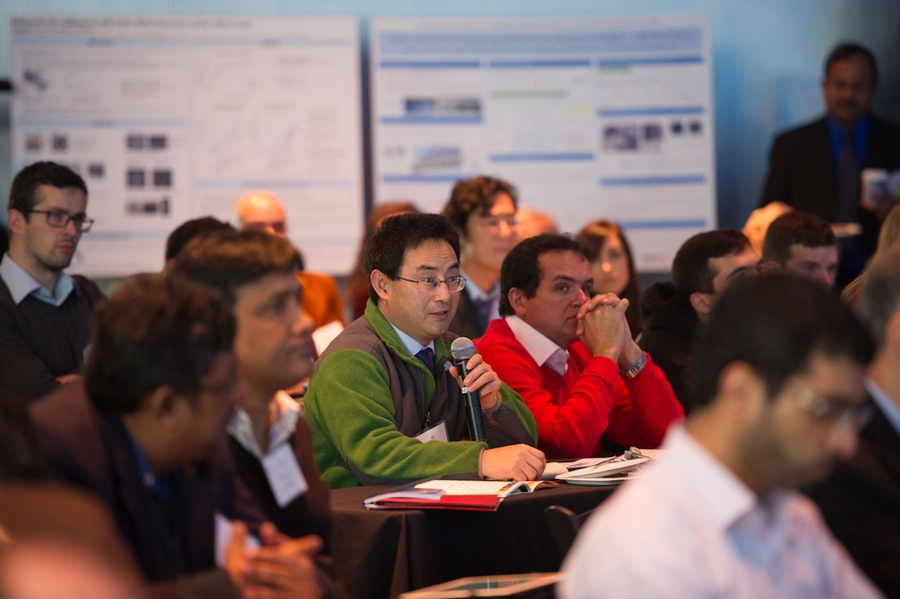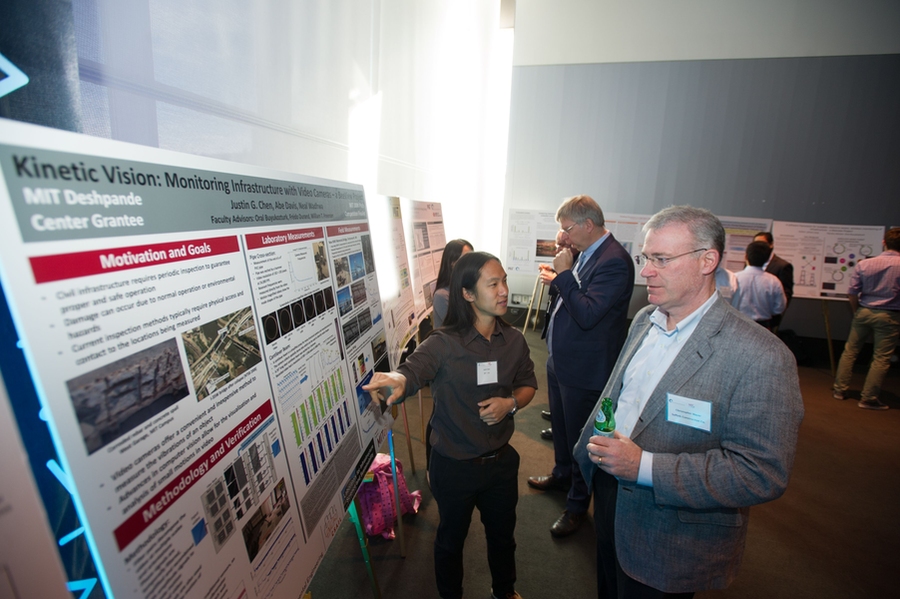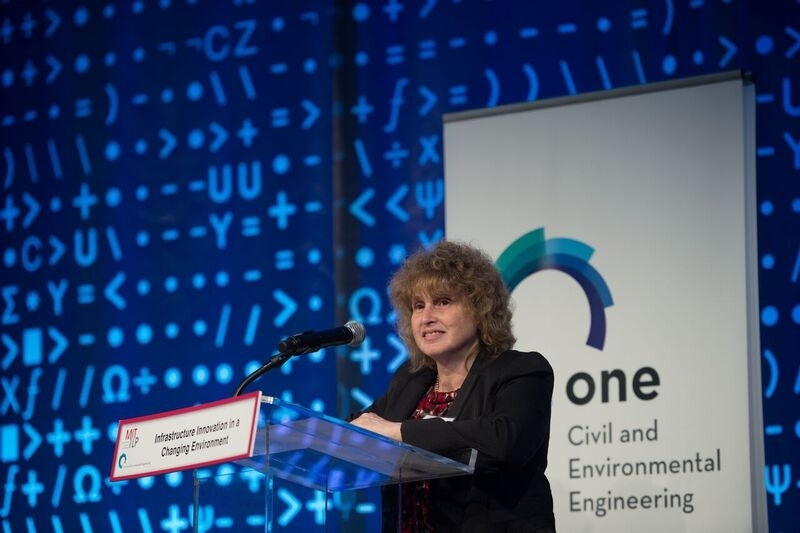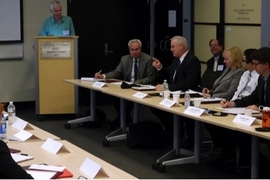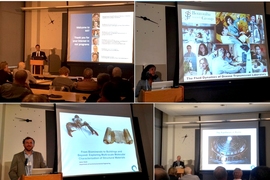Infrastructure is the material backbone of society — the structures and systems that allow people to live and work and build societal wealth. Planning, building, and operating infrastructure has never been so challenging, however, while presenting so many new opportunities to advance civilization.
On Nov. 20, MIT hosted a full-day, thought leadership forum, the Infrastructure Innovation in a Changing Environment Conference, co-hosted by the Department of Civil and Environmental Engineering (CEE) and the Industrial Liaison Program (ILP). The event brought together 25 prominent business, government, and academic luminaries to share their knowledge, insights, and successes with almost 200 attendees from within MIT and beyond.
The diverse program showcased all the many infrastructure forces at play today, including new ways to look at structural design, materials and mechanics, climate change, energy, transportation, food security, and large-scale systems integration.
“There exists a global race for the best approaches to innovate in infrastructure,” said the McAfee Professor of Engineering and conference chair Markus Buehler, “and whoever wins the race will provide critical leadership towards a sustainable future. We will need to engage the brightest minds to develop the fundamental knowledge to drive innovation.”
This movement has the power to change the human experience dramatically, and MIT is leading the charge. Typical questions are: How do we handle so many new people who will want to drive? How do we bring energy to all the new cities? How do we transfer energy from new sources like wind in remote regions to the cities far away? How do we ensure infrastructure that is increasingly connected to the web is safe from malicious attacks and other threats?
Answers to these and other questions, exacerbated by rising world population growth, require a comprehensive understanding of complex issues and interdisciplinary action.
How do we handle so many new people who will want to drive?
The White House’s Rebuild America campaign reports that 65 percent of the country’s major roads are rated in less than good condition, 25 percent of bridges require significant repair or cannot handle today’s traffic, and 45 percent of Americans lack access to transit.
Two conference keynote speakers — Massachusetts Secretary of Transportation Stephanie Pollack ‘82 and Harvard University’s Ernest L. Arbuckle Professor of Business Administration Rosabeth Moss Kanter — emphasized always putting people first when improving infrastructure.
In her presentation, “What Makes Infrastructure Great?” Pollack said engineers need to focus on why they do what they do. “Transportation is not important for what it is; transportation is important for what it does,” she explained. “Get people where they need to go and connect them to opportunity. Shape and support the economy of communities and regions.” She presented examples of her top five professional mantras: solving the right problem; working for customers and users; working for neighbors; solving long-term needs; and moving from “projects” to “investments.”
Kanter took the stage to talk about lessons to learn from her new book, “MOVE: Putting America’s Infrastructure Back in the Lead.” Her examples ran the gamut from leadership lessons learned from a perpetually-thwarted-but-ultimately-implemented Miami tunnel project, to ways technology and new paradigms are disrupting the transportation industry today. She summarized that leadership, technology innovation, connections, and inter-modality will mobilize people to put the U.S. infrastructure back in the lead. Adapting infrastructure to meet the needs of citizens, and not the other way around, is the fastest route to free human potential.
On Dec. 4, President Obama signed a 5-year, $305 billion bill into law to boost highway and transit spending, acknowledging it is “just the first step in the right direction.”
“The conference did a wonderful job in broadening the discussion of this very important issue and field,” Kanter said.
How do we design, create, and pay for more resilient infrastructure?
By 2020, China aims to integrate 100 million rural migrant workers into urban life. Its plans include building a megacity that will be larger than all of the population of Japan. In addition, India will need to build a new city the size of Chicago every year to accommodate its massive growth needs by 2030.
These challenges and opportunity showcase the immense need for innovation — in science, technology, policy, and financing.
Başar Arioğlu ‘89, chairman of Yapi Merkezi Construction and Industry of Turkey, presented details and video of his company’s amazing project that connects two continents: the massive 3,400-meter Eurasia Tunnel Project that links Europe and Asia. It includes a double-deck tunnel configuration and is 107 meters from sea level at its deepest point. When completed, the tunnel is estimated to save up to two hours per day of travel time for people commuting to work across the divide. Arioglu talked about the complex and variable geology and high seismology of the area, including a description of some of the innovative drilling equipment and techniques. He equally emphasized how the different economy post-2009 affected financing for the multi-year project. And he proudly mentioned his company received top awards for both innovative financing as well as for advancing civil and construction engineering.
Another international speaker, the Republic of Indonesia Minister of Public Works Basuki Hadimoeljono, talked about how his country is in the midst of a $68 billion building and development phase — including the construction of at least 49 dams over five years — requiring much more public-private investment and shrewd planning to meet short deadlines and population growth needs.
“To be an engineer is a must, but not sufficient, to be a leader,” he said in response to an audience question about whether more governments should hire engineers as civic leaders. “I also need communications and diplomatic skills to do my job well.”
Caitlin Mueller, assistant professor in the MIT Department of Architecture with a joint appointment in CEE, offered that architectural design and structural engineering analysis go hand in hand, but often are not considered or studied together. Existing software tools are often disconnected, too, she added. She’s trying to change this in her work and offered an example of designing a building’s cantilevered roof, one that would optimize light, shade, and energy use. Designing the roof geometrically doesn’t translate well into the physical adaptation, she said. Instead, she’s exploring developing both computational and fabrication technology. For example, rather than use a digital fabrication technique which builds a 3-D structure layer-by-layer, she’s researching the safety and performance of stress line “additive” manufacturing which puts 3-D outputs exactly in the right place. This latter solution can be used in the different ways forces are flowing, she said, enabling greater control and results.
What can we do differently?
Reframing a problem often unlocks innovation. The mantra of Pedro Reis, associate professor in CEE and the Department of Mechanical Engineering, was that people should shift to a new paradigm and embrace mechanical instabilities of slender structures for function. He used the example of pipelines laid under the ocean that can exhibit compliant behavior due to their slender geometrics. Their elastic grid shells often buckle, but instead of perceiving that as an imperfection, buckling actually helps shape the lines to better maneuver uneven ocean floors. His goal is to revive the study of structural mechanics with a fundamentally different perspective: from seeing an imperfection as a failure, to seeing it as an application.
"This conference was a phenomenal gathering to establish bridges between the cutting edge research that is happening at MIT and engineering practice,” Reis said. “It is precisely energizing and catalytic events like this that help place MIT at the forefront of innovative thinking and doing."
Brian Tucker represented his non-profit organization, GeoHazards International. His company promotes social science innovations and Earth safety as it relates to earthquakes and tsunamis. The company also works with communities on Earth science innovations to design and implement strategies that prevent or mitigate damage and casualties caused by quakes. In particular, he talked about engineering innovation he’s doing in Padang, Indonesia, to improve earth safety in schools, the leading infrastructure concern of that city’s government.
“The world’s investment in natural disaster prevention is only 1-4 percent of what it spends in disaster response,” he said, arguing there’s a lot of room for improvement in funding preventive measures.
Ensuring air quality for everyone
Breathing Beijing's air is the equivalent to smoking almost 40 cigarettes a day. As more people shift to living in cities, sustainable urban development will require greater quantification of city dynamics.
A presentation by MIT alumnus Steven Koonin ‘75, director of the Center for Urban Science and Progress (CUSP) at New York University and former undersecretary for science at the U.S. Dept. of Energy, depicted “The Emerging Field of Urban Informatics.” He and his team have spent the last two years capturing big data about Manhattan by repeatedly photographing the city skyline, often with thermal infrared imaging. His work contributes to the emergence of a new field called “city science.”
During his presentation, Koonin stopped on a slide and pointed out a plume of gases spewing from an unknown building in the distance. This "digital exhaust" as he calls it, helps scientists better understand the localization of contaminants that impacts air quality. CUSP plans to implement a project in February 2016 using inexpensive sensors deployed in parts of the city that will collect and anonymize more data samples to help track air quality, plus energy use, light and noise pollution, traffic, and even residents’ sleep patterns. The center’s goal is to help document the pulse of the city in its various dimensions to help people make some macro observations from micro behavior.
“What does it mean to instrument a building?” he asked. “If we can properly apply and integrate data we capture, we can make government more efficient, enable the private sector to implement new services, and promote greater citizen engagement in their communities.”
CEE Professor Jesse Kroll echoed Koonin’s talk by introducing a recent student senior year capstone project, Clairity, which uses low-cost sensors to track and analyze a community’s air quality. Clairity is in use across MIT’s campus, so Kroll encouraged the participants to look for the students’ devices posted inconspicuously on lamp posts and other structures. His work in atmospheric chemistry seeks to better understand the composition of pollution specific to a single community or area, so preventive measures and adaptive strategies can be better targeted and engage those directly impacted.
How climate change and the environment affect infrastructure
The effects of climate change — such as heat waves, rising sea levels, and more severe storms — are already being felt across the U.S. The nation’s energy infrastructure is especially vulnerable, which can pose a serious threat to America’s prosperity, national security, energy security, and quality of life
Boston University professor and dean of the Frederick S. Pardee School of Global Studies Adil Najam '96, pointed out that if people imagined the Earth from outer space and visualized it as a singular sovereign state, it would still be considered a developing country. He referenced an inverted champagne glass to illustrate how power is concentrated and resources accessible only to a privileged few. In his talk, “Infrastructure in the Age of Climate Adaption: It Will Be a Mess,” he reviewed humanity’s current status, but offered hope through potential improvements in globalization, infrastructure innovation, and collaboration.
The conference’s lunchtime panel featured associate department head and CEE Professor Elfatih Eltahir, who talked about the environmental engineering science behind big-dam construction. In his talk, “Storing water from times of plenty to times of deficit,” Eltahir explained that it is important to build infrastructure that serves society today and also anticipates the effects of future climate changes.
Ensuring Web-connected infrastructure is safe
The Organization of American States reports that destructive attacks on critical infrastructures and key assets are on the rise. According to one survey, cybercriminals are now targeting power grids, water supply systems, and other vital services:
- 54 percent of respondents said attackers had tried to “manipulate equipment” through an industrial control system;
- 44 percent of survey respondents said attackers tried to destroy information; and
- 40 percent had attempted to shut down computer networks altogether.
CEE Assistant Professor Saurabh Amin stressed the interdisciplinary field of systems engineering as an integral part of infrastructure innovation in his talk, “Building Cyber-enabled Resilience in Infrastructure Networks.”
“We cannot just evaluate materials and structures for points of failure,” he said, “because today our communications networks, sensor networks, and many other critical data systems are interconnected with these structures. We must better manage the vulnerabilities this new reality represents.”
He pointed out the need for better control of large-scale urban water and electricity networks to keep them resilient against both faults and attacks. He talked about new online tools — steeped in data, strategic thinking, and mathematical algorithms — to support the burgeoning field, plus new sensing, actuation, and communications technologies to detect and respond to system crashes, external hacks, or malicious insiders. Game theory is a popular method used for strategizing both within and outside the classroom.
Besides the keynotes and lectures, another important aspect of the day was CEE students and postdocs showcasing their research at a poster session, with 10 of the group selected to present in rapid-fire succession on stage to the full audience. The program overall lent ample proof of how far the civil and environmental engineering profession has come, and of its continued pursuit to help people everywhere live better, stay healthy, and feel more secure.
"The challenges of renewing our infrastructure are formidable,” said MIT Corporation member and conference attendee Jim Champy '63. “But there is also the opportunity to build new and valuable infrastructure that technology now enables. The conference was filled with ideas and actions already underway. It brought together thoughtful people in fields of engineering, science, and policy. The students who presented their work were inspiring. These are our future leaders, being mentored by the best minds."
Preparing the next generation to tackle the world’s infrastructure problems
Millennials — those currently in their mid-teens to early 30s — will couple business savvy with a global conscience, and expectations of morally-conscious conduct will go hand-in-hand with shareholder value maximization.
Professor Fiona E. Murray, associate dean for innovation at the MIT Sloan School of Management and co-director of the MIT innovation Initiative, used her speech, “Taking Ideas to Impact,” to emphasize the unique way MIT educates its students. “Our students are urged to solve problems and then quickly scale the innovations and ideas for greatest impact,” she said.
Buehler concluded the conference with a realistic, yet hopeful, prognosis:
“Our global society’s future falls to those who want to fulfill a higher purpose by embracing big engineering strategies,” he said, defining big engineering as creating small change with large-scale impact on infrastructure, the environment and people. “Ingenuity, innovation, and the ability to adapt and change course through times of uncertainty, disruption, and complexity ultimately will determine humanity’s fate.”


